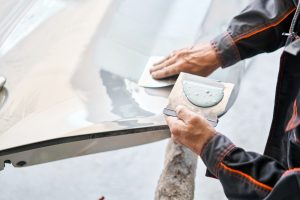Understanding Auto Body Fillers: A Comprehensive Guide
When it comes to maintaining the sleek and smooth appearance of your car, auto body fillers play an indispensable role.
These miraculous substances have the power to erase unsightly dents, scratches, and imperfections, restoring your vehicle to its former glory.

In this comprehensive guide, we’ll take a look at auto body fillers, exploring their various types, applications, and the secrets to their successful use.
Whether you’re a seasoned auto body professional or a curious car owner looking to tackle your first repair, this guide will equip you with the knowledge you need to master the art of auto body fillers.
What are Auto Body Fillers?
Auto body fillers, also known as car body putty or simply body filler, are a type of resin-based compound used to fill dents, scratches, and imperfections on vehicle exteriors.
Their primary purpose is to create a smooth, even surface that can be sanded and painted over, effectively concealing any damage and restoring the car’s aesthetic appeal.
Types of Auto Body Fillers:
Polyester Fillers
The most common type of auto body filler, known for its versatility and ease of use.
- Pros: Easy to sand, quick-drying, and affordable.
- Cons: Not as strong or durable as other types, may absorb moisture over time.
Fiberglass-Filled Fillers
Fillers that are reinforced with fiberglass strands or fibers for added strength and durability.
- Pros: Excellent for repairing large holes or areas with significant damage, strong and durable, and provides additional reinforcement.
- Cons: More challenging to apply and shape, rougher texture requiring additional finishing work, may require additional layers for a smooth finish.
Metal Fillers
Fillers that contain metal particles, such as aluminum or steel, for added strength.
- Pros: Ideal for repairing metal surfaces, resistant to rust and corrosion, excellent heat resistance.
- Cons: Harder to sand, may require special tools for shaping, and more expensive.
The Role of Auto Body Fillers in Car Repair
Auto body fillers play a crucial role in car repair, serving several important functions:
Damage Repair
The primary role of auto body fillers is to repair various types of damage, such as dents, scratches, and holes, in a vehicle’s body. By filling in these imperfections, fillers help restore the car’s smooth and even surface.
Rust Prevention
Some types of fillers, especially those with rust-inhibiting properties, can help prevent the spread of rust on metal surfaces. By sealing off exposed metal, they protect it from moisture and other elements that can cause rust. However, some types allow moisture to be absorbed, so priming and painting needs to be done shortly after repairs.
Cost-Effective Repairs
Using auto-body fillers is often a more cost-effective solution compared to replacing entire body panels. It allows for localized repairs that can significantly extend the life of a vehicle’s body without the need for expensive replacements.
Structural Integrity
In some cases, fillers can also contribute to the structural integrity of the vehicle. For example, epoxy fillers can provide additional strength to repaired areas, ensuring they can withstand the stresses of daily use.
Overall, auto body fillers are an essential tool in the car repair process, enabling both professionals and DIY enthusiasts to achieve high-quality, durable repairs that maintain the vehicle’s appearance and value.
Proper Preparation and Application
Proper preparation and application are critical for achieving effective results with auto-body fillers. We will go more in-depth with these techniques in another article.
Correct Mixing
Many fillers, especially two-component types like epoxy fillers, require precise mixing of the filler and hardener. Incorrect ratios can affect the filler’s curing time, strength, and overall performance.
Surface Preparation
Before applying filler, the surface must be thoroughly cleaned and sanded. Any dirt, grease, or rust can prevent the filler from adhering properly, leading to poor results and potential future issues.
Sanding
Proper sanding is crucial for achieving a smooth, seamless finish. Starting with coarser grits and progressing to finer grits ensures the filler is shaped correctly and blends with the surrounding surface.
Application Technique
The way the filler is applied can impact the final outcome. It should be applied in thin, even layers to avoid air bubbles and ensure a smooth surface. Over-application can lead to excessive sanding and potential distortion of the repair area.
Curing Time
Each filler has a specific curing time that must be respected. Rushing the process by sanding or painting too soon can compromise the repair’s integrity and appearance.
By paying attention to these aspects of preparation and application, you can ensure that your auto body filler repairs are durable, visually appealing, and long-lasting.

